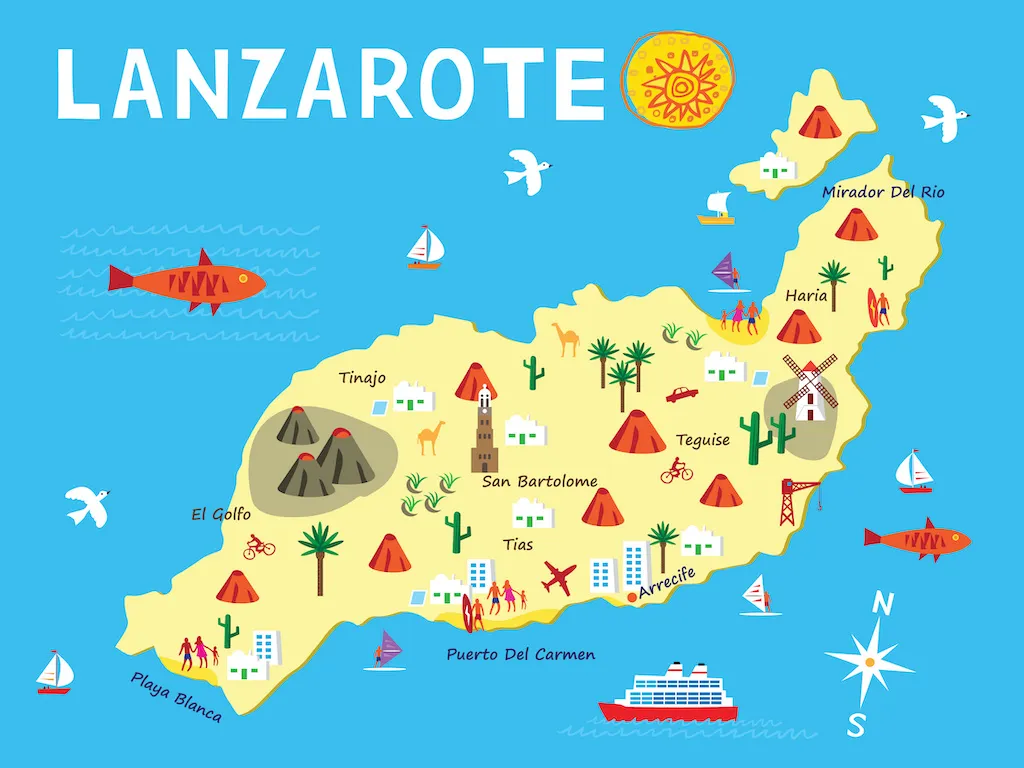Lanzarote, the easternmost of the Canary Islands, beckons travellers with its volcanic landscapes, pristine beaches, and unique cultural charm. But amidst its allure lies a question often overlooked: Just how big is Lanzarote? In this exploration, we unveil ten eye-opening metrics that shed light on the island’s sheer scale and grandeur.
How Big is Lanzarote in Terms of Geographical Area?
Lanzarote spans approximately 845.94 square kilometres, making it the fourth-largest of the Canary Islands. This relatively modest size belies its diverse terrain, from rugged volcanic peaks to tranquil coastal stretches.
How Big is Lanzarote’s Coastline?
The island boasts a coastline that stretches for over 213 kilometres, offering an abundance of pristine beaches, hidden coves, and dramatic cliffs to explore. From the golden sands of Playa Blanca to the rugged shores of Famara, Lanzarote’s coastline is a testament to its natural beauty.
How Big is Lanzarote’s Highest Point?
At 671 metres above sea level, the summit of Peñas del Chache stands as Lanzarote’s highest point. From this vantage point, visitors can marvel at panoramic views of the island’s volcanic landscape and the shimmering waters of the Atlantic Ocean.
How Big is Lanzarote’s Population Density?
Despite its relatively small size, Lanzarote is home to a population of over 150,000 residents, resulting in a population density of approximately 178 inhabitants per square kilometre. This figure is highest in the island’s urban centres, such as Arrecife and Puerto del Carmen.
UNESCO Biosphere Reserve
In 1993, Lanzarote was designated as a UNESCO Biosphere Reserve in recognition of its unique blend of natural beauty and sustainable development. This status underscores the island’s commitment to preserving its fragile ecosystems and cultural heritage for future generations to enjoy.
National Parks and Protected Areas
Lanzarote is home to several national parks and protected areas, including Timanfaya National Park, where visitors can witness the island’s volcanic origins firsthand. These protected areas play a vital role in conserving Lanzarote’s natural habitats and endemic species.
Length of Roads
With over 1,200 kilometres of roads crisscrossing its terrain, Lanzarote offers ample opportunities for exploration by car or bike. From scenic coastal drives to winding mountain roads, the island’s extensive road network provides access to its most remote and breathtaking vistas.
Depth of Caves and Tunnels
Beneath Lanzarote’s surface lies a network of caves and tunnels formed by volcanic activity over millions of years. The Cueva de los Verdes and Jameos del Agua are among the island’s most famous subterranean attractions, offering visitors a glimpse into its geological past.
Length of Hiking Trails
For outdoor enthusiasts, Lanzarote boasts a network of hiking trails that traverse its varied terrain. Whether exploring the lunar landscapes of Timanfaya or trekking along the coastal cliffs of Los Ajaches, there’s no shortage of opportunities to immerse oneself in the island’s natural beauty.
Economic Impact of Tourism
Tourism plays a significant role in Lanzarote’s economy, generating revenue and employment opportunities across various sectors. From hotels and restaurants to guided tours and water sports, the tourism industry contributes to the island’s prosperity while also posing challenges related to sustainability and conservation.
Conclusion
In conclusion, the question of how big is Lanzarote goes beyond mere measurements of geographical size. It encompasses the island’s rich natural heritage, vibrant cultural identity, and sustainable development efforts. By delving into these ten eye-opening metrics, we gain a deeper appreciation for how big Lanzarote truly is and the myriad experiences it offers to travellers from around the world. Whether you are exploring its extensive coastline, hiking its diverse trails, or marvelling at its volcanic landscapes, understanding how big Lanzarote is enriches every aspect of your journey.
FAQs
1. How big is Lanzarote compared to other Canary Islands?
Lanzarote is the fourth-largest of the Canary Islands, covering an area of approximately 845.94 square kilometres. While smaller than Tenerife and Gran Canaria, it offers a unique blend of landscapes and attractions.
2. How big is Lanzarote’s population?
Lanzarote has a population of over 150,000 residents. This relatively high population density, especially in urban areas like Arrecife and Puerto del Carmen, adds to the island’s vibrant cultural atmosphere.
3. How big is Lanzarote’s tourism industry?
Tourism is a major economic driver for Lanzarote, attracting millions of visitors each year. The island’s diverse attractions, from beaches to volcanic parks, play a significant role in its thriving tourism sector.
4. How big is Lanzarote’s road network?
Lanzarote boasts over 1,200 kilometres of roads, making it easy to explore the island by car or bike. This extensive network connects visitors to both popular tourist spots and hidden gems.
5. How big is Lanzarote’s commitment to sustainability?
Lanzarote’s designation as a UNESCO Biosphere Reserve highlights its significant commitment to sustainability. The island’s efforts to balance tourism with conservation underscore how big is Lanzarote’s dedication to preserving its natural and cultural heritage for future generations.
Also read: Festive Fun by the River: London Bridge’s Best Winter Attractions




Leave a Comment